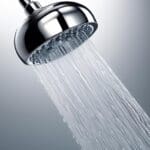Facing a Delta shower head leak can feel like tackling a gushing waterfall in your own bathroom. You’re not alone in this battle against unwanted drips and wasted water. By following five clear, straightforward steps, you’ll effectively silence that persistent leak and restore peace to your shower experience.
Key Takeaways
- Observe leaks with water on/off to identify source
- Check for visible damage and leaks in shower head and connections
- Clean and unclog shower head using soap and brush/toothpick
- Replace worn-out parts and reassemble securely before testing functionality
Identify the Leak Source
To accurately identify the source of a leak in your Delta shower head, start by observing whether the leak occurs with the water turned on or off. This initial step is crucial in pinpointing the problematic area. If the leak persists even when the water is off, it’s likely an issue with the shower cartridge inside the valve, not the shower head itself.
However, when the water is on and you notice the leak, focus on common leak points: the swivel or threads on a fixed shower head, the connector on a hand-held model, or the connections of a shower hose. Despite a leak in these areas, you’ll observe that the majority of water still flows through the main shower head.
Next, conduct a visual inspection for any visible damage, such as cracks or splits on the shower head. Identifying these signs early can save you time and effort in troubleshooting and repairing the leak.
Inspect for Shower Head Damage
After identifying the source of your Delta shower head leak, it’s crucial to closely examine the shower head for any signs of physical damage, such as cracks or splits. Inspecting your shower head meticulously is the key to ensuring a leak-free experience. Pay attention to the swivel, threads, and connections, as these are frequent culprits for leaks.
- Cracks or Splits: Even the smallest crack can lead to significant water leakage.
- Leaks or Drips: These are tell-tale signs that something isn’t right. Imagine the annoyance of a constant drip, drip, drip.
- Swivel and Threads: Loose or damaged parts here can disrupt your peaceful shower sanctuary.
- Shower Arm Connection: A compromised connection can result in unexpected showers outside of the tub.
- Soap Test: Soak the shower head in a soap solution to identify hard-to-see deposits that could cause leaks.
If you discover any damage, it might be time to repair or replace specific parts of your shower head. Addressing these issues promptly can save you from the frustration of ongoing water wastage and ensure a serene and leak-free shower experience.
Clean and Unclog Shower Head
Before tackling the task of cleaning and unclogging your Delta shower head, ensure the main water supply is off to prevent any unexpected mishaps. This crucial step safeguards you against any unwanted surprises as you embark on the repair process.
Firstly, you’ll need a wrench or pliers to carefully remove the old shower head. It’s important to handle this step with care to avoid damaging the shower arm. Once removed, it’s time to address the clog and build-up that might be affecting your shower’s performance.
Submerge the shower head in a soap solution for a few hours. This natural solution works wonders in dissolving mineral deposits and debris that hot water alone can’t remove.
After the soaking period, inspect the shower head for any remaining clogs. If necessary, use a small brush or a toothpick to gently clear them. Next, check the washer for any signs of damage. If it’s compromised, replace it to ensure a tight seal.
Replace Worn-Out Parts
Having tackled the cleaning and unclogging of your Delta shower head, it’s crucial to now focus on identifying and replacing any worn-out parts to ensure its optimal functioning. Over time, parts like the shower head washers or the cartridge may wear out, leading to leaks even when the water is turned off. Here’s what you need to do:
- Identify the worn-out parts in your shower head that need replacing.
- Purchase replacement parts, such as new shower head washers, thread seal tape, and possibly a new cartridge.
- Clean the shower arm and inside of the shower head thoroughly to remove any debris or buildup before installing new parts.
- Install the new parts carefully, reapply thread seal tape around the threads to ensure a watertight seal, and reinstall the shower head.
Reassemble and Test Shower Head
Once you’ve replaced any worn-out parts, it’s time to reassemble your Delta shower head and test it for leaks. Start by reattaching the decorative metal collar. To ensure it’s snug without causing damage, tighten it using a rubber strap wrench. This step is crucial for maintaining the aesthetic appeal while ensuring functionality.
Next, take a moment to inspect the cartridge for any signs of damage or faulty seals. If you find any issues, replace the cartridge, making sure it aligns properly with the valve. This is a critical step in preventing future leaks.
After the cartridge is securely in place, hand tighten the collar. Then, use the strap wrench to firmly secure it, ensuring it’s tightly wrapped around the shower fixture. This double-check ensures everything is compact and ready for use.
Frequently Asked Questions
Why Does My Shower Leak When the Shower Head Is On?
Your shower leaks when it’s on because there’s likely an issue with the connections in the shower head itself, such as the swivel, threads, or connector, which need checking and possibly tightening or replacing.
Why Does Faucet Leak When Shower Is On?
Your faucet might leak when the shower’s on due to a malfunctioning diverter valve, which directs water to the shower head. It’s likely worn out or clogged, causing water to escape through the faucet.
How Do I Stop My Shower Valve From Leaking?
To stop your shower valve from leaking, first identify the leak’s cause. Then, you might need to replace the washer or apply thread seal tape. If it’s beyond DIY, consider consulting a professional.
How Do You Tighten a Shower Head so It Doesn’t Leak?
To tighten a shower head and stop leaks, you’ll need to unscrew it, check and replace worn washers, reapply thread seal tape, then screw it back on tightly. Test it to ensure there’s no leak.





